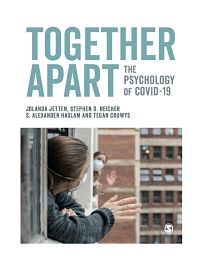An Introduction to Intergroup Relations and COVID-19: Excerpt from ‘Together Apart’
Hopefully, one day soon we will live in a world where COVID-19 does not dominate every aspect of our lives. It is nonetheless clear that when this day comes, the world will have been changed dramatically. To understand these changes, we need to explore the role of collective processes in determining both how the COVID-19 story unfolds, and the ways the virus is contained and responded to. Viruses do not discriminate, but just about every other aspect of society does. Everything from a person’s capacity to avoid infection to their likelihood of avoiding financial hardship is determined by group-level status and power inequalities, many of which are determined by pre-COVID-19 intergroup relations. It is an understanding of these power and status dynamics at the collective level that will help us understand the long-term impact of this pandemic on society and, by extension, the individuals in it. This knowledge is also necessary for us to work collectively to craft the best possible future.
In this final section of the book, we focus first on the effect of pre-existing group-based inequalities on the COVID-19 response — those between the poor and the wealthy, between minorities and majorities, and between the disadvantaged and advantaged (Chapter 17). We also consider how COVID-19 is likely to shape those relationships. We then outline how polarization and division along ideological lines determine the way that groups respond to the immediate challenges that the COVID crisis poses, and how the crisis will impact those political rifts (Chapter 18). After this, we explore how COVID-19 has colored (and will continue to colour) our perceptions of specific groups in society (e.g., Asians), triggering new forms of intergroup hostility and exacerbating and legitimizing some old forms of prejudice and stereotyping (Chapter 19). Clearly, solidarity and a sense of shared identity will be crucial for holding communities together as we seek to cope with the long-term societal consequences of the virus. We draw the book to a close with a discussion of how this might be achieved (Chapter 20).

Explore the section of Together Apart on intergroup relations
Prejudice and Discrimination| Yuen J. Huo
Inequality | Jolanda Jetten
Common Identity and Humanity | John F. Dovidio, Elif G. Ikizer, Jonas R. Kunst, & Aharon Levy
Societal Polarization | Charlie R. Crimston & Hema Preya Selvanathan






























































































